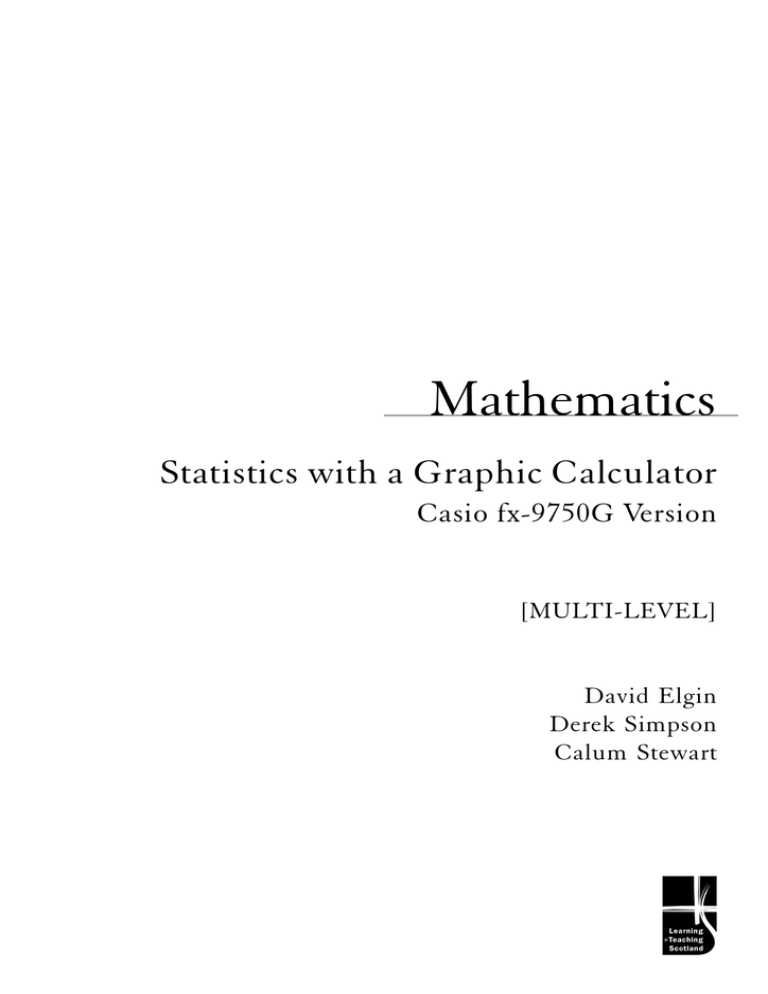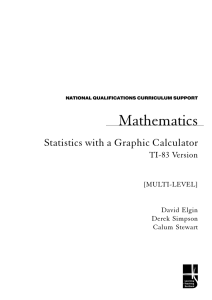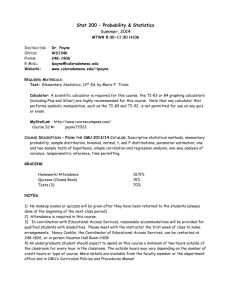abc Mathematics Statistics with a Graphic Calculator Casio fx-9750G Version
advertisement

Mathematics Statistics with a Graphic Calculator Casio fx-9750G Version [MULTI-LEVEL] David Elgin Derek Simpson Calum Stewart abc First published 2001 © Learning and Teaching Scotland 2001 This publication may be reproduced in whole or in part for educational purposes by educational establishments in Scotland provided that no profit accrues at any stage. Acknowledgement Learning and Teaching Scotland gratefully acknowledge this contribution to the National Qualifications support programme for Mathematics. The help of Allan Duncan in editing this material is acknowledged with thanks. ISBN 1 85955 908 5 Learning and Teaching Scotland Gardyne Road Broughty Ferry Dundee DD5 1NY www.LTScotland.com CONTENTS iv Introduction Part 1. 2. 3. 4. 1 Lists and Data Entry Median, Quartiles and Boxplots Two Variable Statistics Mean and Variance of Discrete Random Variables 1 4 9 13 Part 5. 6. 7. 8. 9. 10. 11. 12. 2 Summary Statistics for a Single Variable Boxplots Marks in Exams Highway Code Fire Damage Breaking Strength of Cables Breeding Gulls Pendulum Lengths and Periods 15 20 24 26 29 31 34 37 MATHEMATICS iii INTRODUCTION Learning and Teaching Scotland has produced this material as part of a national strategy of providing practical support to help schools implement the proposals in Advanced Calculators and Mathematics Education: A Paper for Discussion and Development (Scottish CCC, 1999). This pack is designed to follow up the earlier one entitled Using a Graphic Calculator. It should be used in the same way as the previous pack and has similar aims, objectives and teaching approaches. As before, the materials may be used with students or as a basis for staff development. The topics cover a range of statistical content at General and Credit Levels of Standard Grade and also at Intermediate 1, Intermediate 2 and Higher levels. The activities in this pack should be teacher led. They are aimed at both the experienced and less experienced graphic calculator user alike. Some topics assume a certain amount of prior knowledge of the Statistics content while others actually introduce the new concepts. In Part 1 students learn how to enter and edit data as lists in the calculator and how to use these to find both one and two variable statistics and produce statistical plots such as the boxplot and the scattergraph. Linear regression is then examined and you will be shown how to calculate the equation of the regression line as well as how to plot it. Part 2 consists of a collection of activities where the statistical content is embedded in real life contexts and in practical investigations. Some of the content of Part 1 is revisited before quadratic, exponential and power regression are introduced. Almost all the topics are accompanied by short practice exercises designed to reinforce the student’s newly acquired skills with the calculator. The data sets involved are all so small that entry into lists is neither time consuming nor difficult. iv MATHEMATICS

![abc Mathematics Mechanics 2 [ADVANCED HIGHER]](http://s2.studylib.net/store/data/013012728_1-4d6f02744ec91e7709a65e29b43fc4e2-300x300.png)

